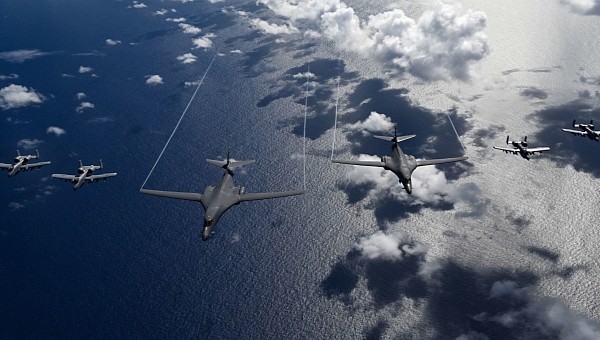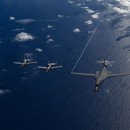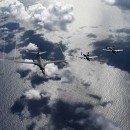The answer is a family of two Bones and four Warthogs in combat formation. It just so happened that we found the family during a mission flight from Guam – the date is unknown. What a beautiful shot: a pair of B-1B supersonic heavy bombers ($317M each) and four A-10 Thunderbolt air support jets ($9.8M a piece) flying in formation. Especially with the backdrop of the Pacific Ocean on a sunny day.
And immediately, we think about a couple of birds teaching their offspring the martial art of aerial life. With their wings fully extended forward, the two bombers fly slowly, allowing the A-10s to keep up with them. The details did not go unnoticed by viewers of Air Combat Command's social media post.
"Close to stall speed" is the description one commentator used for the B-1 Lancer supersonic bombers, and for a good reason. The quad-turbojet "Bone" (the nickname comes from the B-One spelling of its name) can cruise at Mach 1.2+ (900 mph/1,448 kph) at sea level, while the A-10 Thunderbolt only tops half that number: 420 mph (675 kph).
Nonetheless, the four aircraft are a somewhat nostalgic image. The straight wings perpendicular to the fuselage is something we most often identify with warbirds of 80 years ago, as most modern airplanes follow a different design philosophy. But the flock of jet-powered arsenal in the photo is a scene of epic proportions.
Really, it is; we tweaked the Instagram post to put together the bird's eye view of the "terror birds" capable of eradicating an entire army in a matter of seconds. That's not a metaphor, as the bombing duo, even depraved of its nuclear capabilities, can still drop 75,000 pounds (34 tons) of Rest in Peace essence anywhere on the planet.
With a range of unlimited proportions, thanks to aerial refueling, the supersonic hell-bringer can fly high and low and drop its massive payload with deadly accuracy. Four General Electric afterburning turbofans (30,000+ lbs. each, or 133,000 kN) jot the max takeoff weight of almost half a million pounds (477,000 lbs., or 217 tons) to over 30,000 feet (nine kilometers) high.
The deadly jet bomber can carry over 265,000 lbs. of fuel (120 tons) to feed its thirsty thrusters and keep its massive body aloft. When extended, the wings span 137 feet (41.8 meters) and 79 feet (24.1 meters) swept back. The B-1 is 146 feet (44.5 meters) long, 34 feet (10.4 meters) tall, and weighs in at 190,000 pounds (86 tons) dry weight.
As for the Warthog, there isn't a more recognizable active-duty shape among airspace enthusiasts: the tank obliterator is the most famous flying canon in warfare history. The plane is built around the 18-feet-long GAU-8/A Avenger rotary canon capable of spilling 3,900 rounds of depleted uranium (30 mm caliber) over a target in one second. If that won't do it, 16,000 lbs. of ordnance (7.2 tons) can crash any enemy party.
The plane has two General Electric turbofans, developing 18,130 lbs. of combined thrust (81,000 kN), rendering the 29,000 lbs. (13 tons) Thunderbolt able to protect a 400-mile radius area (640 kilometers) from a maximum height of 45,000 feet (13.6 kilometers). Unlike its protective parents in the main photo of this article, its speed is just 0.56 Mach (420 mph, 675 kph). And, as we can see, the Thunderbolt is tiny when compared to the Lancers: 53 feet (16 meters) long, 14 feet (4.4 meters) tall, and 57 feet (17 meters) wide from wingtip to wingtip.
"Close to stall speed" is the description one commentator used for the B-1 Lancer supersonic bombers, and for a good reason. The quad-turbojet "Bone" (the nickname comes from the B-One spelling of its name) can cruise at Mach 1.2+ (900 mph/1,448 kph) at sea level, while the A-10 Thunderbolt only tops half that number: 420 mph (675 kph).
Nonetheless, the four aircraft are a somewhat nostalgic image. The straight wings perpendicular to the fuselage is something we most often identify with warbirds of 80 years ago, as most modern airplanes follow a different design philosophy. But the flock of jet-powered arsenal in the photo is a scene of epic proportions.
Really, it is; we tweaked the Instagram post to put together the bird's eye view of the "terror birds" capable of eradicating an entire army in a matter of seconds. That's not a metaphor, as the bombing duo, even depraved of its nuclear capabilities, can still drop 75,000 pounds (34 tons) of Rest in Peace essence anywhere on the planet.
With a range of unlimited proportions, thanks to aerial refueling, the supersonic hell-bringer can fly high and low and drop its massive payload with deadly accuracy. Four General Electric afterburning turbofans (30,000+ lbs. each, or 133,000 kN) jot the max takeoff weight of almost half a million pounds (477,000 lbs., or 217 tons) to over 30,000 feet (nine kilometers) high.
The deadly jet bomber can carry over 265,000 lbs. of fuel (120 tons) to feed its thirsty thrusters and keep its massive body aloft. When extended, the wings span 137 feet (41.8 meters) and 79 feet (24.1 meters) swept back. The B-1 is 146 feet (44.5 meters) long, 34 feet (10.4 meters) tall, and weighs in at 190,000 pounds (86 tons) dry weight.
As for the Warthog, there isn't a more recognizable active-duty shape among airspace enthusiasts: the tank obliterator is the most famous flying canon in warfare history. The plane is built around the 18-feet-long GAU-8/A Avenger rotary canon capable of spilling 3,900 rounds of depleted uranium (30 mm caliber) over a target in one second. If that won't do it, 16,000 lbs. of ordnance (7.2 tons) can crash any enemy party.
The plane has two General Electric turbofans, developing 18,130 lbs. of combined thrust (81,000 kN), rendering the 29,000 lbs. (13 tons) Thunderbolt able to protect a 400-mile radius area (640 kilometers) from a maximum height of 45,000 feet (13.6 kilometers). Unlike its protective parents in the main photo of this article, its speed is just 0.56 Mach (420 mph, 675 kph). And, as we can see, the Thunderbolt is tiny when compared to the Lancers: 53 feet (16 meters) long, 14 feet (4.4 meters) tall, and 57 feet (17 meters) wide from wingtip to wingtip.



















